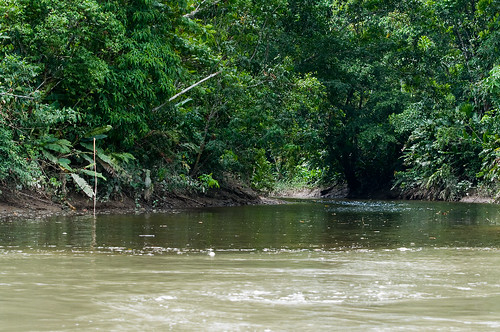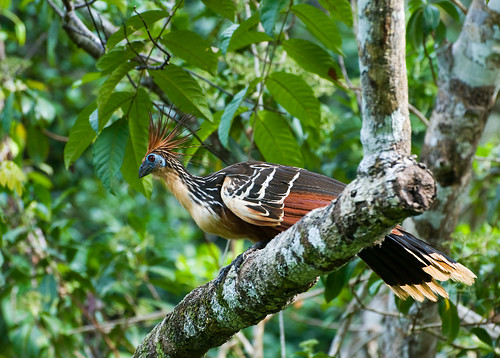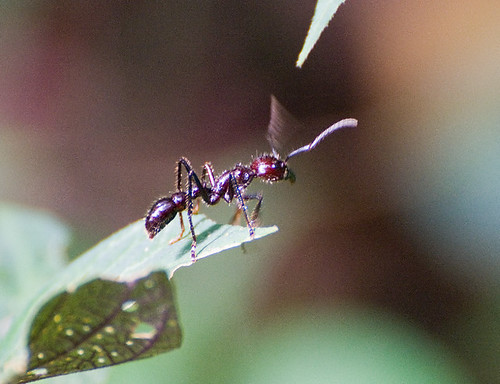The magical leg of the journey started after leaving the Napo River and transferring to our paddle canoe. At a small transfer station we met our guides and climbed into our canoe. At the time, we had no idea how much time we would be in this canoe. Thank goodness there was a pad for our tushes.
We set off quietly down the narrow curvy Anangu river. The jungle serenaded us with sounds from all directions but we couldn't see what was making them due to the dense jungle foliage that lined the river.

It wasn't long before we had our first mammal sighting. Hanging around in a tree over the river was this Brown-throated Three-toed sloth. Fifteen minutes in the canoe and already a new mammal. Awesome!

We got excellent views of this sloth which was exhibiting odd behavior. It was eating the bark off of the tree which is something that the guides hadn't seen before.

I had some issues getting sharp photos of the sloth and I quickly realized that taking hand-held pictures in the dark rainforest from a moving canoe was going to be quite challenging. Luckily for you I won't post the hundreds of blurry shots I took this trip.
Not long after the sloth we had another great encounter. This is a Rufescent Tiger Heron that let us get really close:

And we soon found out why. It was doing a mating dance to impress a female heron about 10 yards away. It would straighten its neck out and then expand some flaps on its neck. It didn't seem very sexy to me, but the female didn't fly away so that must have been a good sign. Maybe I need to try that neck thing in the future.

We decided to add video to our arsenal of toys to chronicle our trip and this heron gave us a good opportunity to try it out. We still have lots of practicing to do but overall we are happy with the videos from the trip. Heron mating dance video.
For the next hour or so we cruised the river slowly and quietly. We saw lots of creatures including large spiders, kingfishers, kites, three kinds of heron, a Great Potoo sleeping high in a tree, a ten foot caiman floating in the darkest bend of the river, and our first snake - a tree boa. We also saw the first of many Hoatzins which is now one of my favorite birds. This prehistoric looking bird is like no other on earth. And its nickname of "Stinky Turkey" made it even more endearing to us.

But, the real highlights were still ahead. Our guides had spotted a troop of Common Squirrel Monkeys hopping through the trees along the river. They were making quite a ruckus jumping through the trees. At one point they ran full speed across a log to get to the other side of the river.

The commotion caused by the squirrel monkeys had an added benefit. Apparently, it awoke something sleeping in a nearby tree hole. Something that was on our list of the top animals that we wanted to see.

This is a nocturnal monkey called the Night Monkey. The locals refer to this monkey as the "Noisy" Night Monkey because it apparently makes loud owl sounds all night. It is very rare to see them out in the daylight even if they were only peeking out at us.

We had one last bird sighting, a Greater Ani, before the river widened and we could see the lodge across the river.

It was a welcome sight. After sitting for so long, neither one of us could feel our butts anymore.

Once the canoe docked, and after many loud groans, we stood up and staggered down the pier towards our refreshing welcome drinks. After a quick orientation, we were shown to our cabin which was marvelous.

With only about an hour of daylight left, we scouted the area around our cabin for creatures and found lots of birds. In fact, a tree of nesting Yellow-rumped Casiques was right outside our cabin and would provide great sounds for us the entire trip since they can imitate other birds.
Black-throated Mango feeding:

Yellow-rumped Casique:

Nesting Tree:

View from our cabin:

After a nice dinner we headed out to search for night creatures. Unfortunately, all of the hiking trails are reachable only by canoe so we didn't have a large area to search. Our total tally that night was one cricket. Not a great night walk. But, it was a great first day.
































